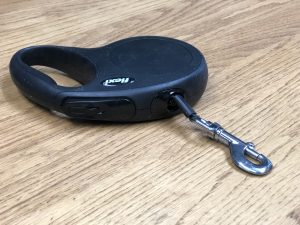Pet Peeves: The Retractable Leash
by Tracie Grubb, DVM, CCRT, cVMA

We assume so much responsibility when we become a pet family. It’s our job to keep our pets healthy, happy, and safe as we would any other family member. Retractable leashes do not help to meet this goal. Most dogs love their daily walks. It’s a perfect time stretch their legs, explore their environment, and bond with their humans. The wrong leash can turn this wonderful activity into a disaster with life-changing effects. Here are just a few reasons why the use of retractable leashes have made my Pet Peeves list.
- HANDLE SIZE: The handles of retractable leashes are difficult for small hands to hold. This is made worse in bad weather. If your child oversees the walking of the dog, the situation just became more risky.
- SOUND: DROPPED LEASH: Dropped leashes are a common problem (See #1). The sound of the heavy handle hitting the sidewalk can startle a nervous or distracted dog resulting in them running away and into harm’s way.
- MECHANICAL SOUND: Sound-sensitive dogs can be easily startled by the vibration of the retracting mechanism in the handle. This can cause more nervous darting and/or long-term stress or behavior problems for the dog.
- LEASH LINE BREAKAGE: Older leashes can break or malfunction at any time. A strong dog can break the nylon cord causing it to snap and ricochet to hit the owner.
- SUDDEN RETRACTION: Injury from sudden retraction can cause serious injuries to the dog’s trachea, neck, or spine.
- LEASH LINE INJURIES: Many injuries directly related to the heavy nylon line have been reported. These range from cuts and burns to strangulations and amputations in both pets and people.
- OTHER INJURIES: A strong dog at the end of the long line can exert enough force to cause the dog walker to suffer a fall.
- OTHER ANIMALS: Animal-to-animal interactions in small spaces (i.e., veterinary clinics, grooming facilities, pet stores) can create havoc and injury if a dog ventures too far while on the retractable leash.
- WASTE MANAGEMENT: Picking up after our pets is an obvious responsibility. Doing so while trying to hold on to the cumbersome leash handle is a challenge that can lead to dropping the leash or someone opting to not pick up the waste because of the hassle.
- “LEAVE IT” BECOMES OBSOLETE: If your dog comes upon something on the ground that could be harmful (i.e., rattlesnake, discarded food, medication, etc…), how would you know if his nose is sniffing 10-25 feet away. If you’ve taught your dog to “leave it,” that training was for nothing.
No leash is perfect. Much depends on training and the relationship between the handler and the pet. But we can make the best decisions for our furry friends to set them up for success and good manners. Using a well-made, 6-foot leash to keep your pet close to you is a good first step.
Talk to your veterinarian if you have questions. They are there to help.
